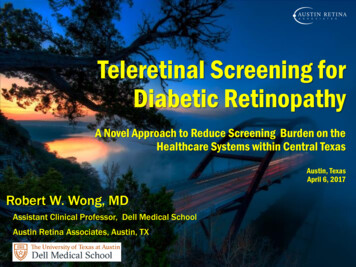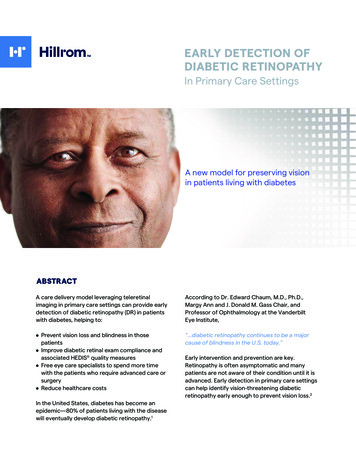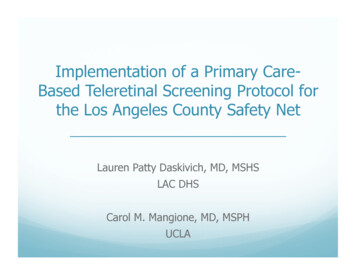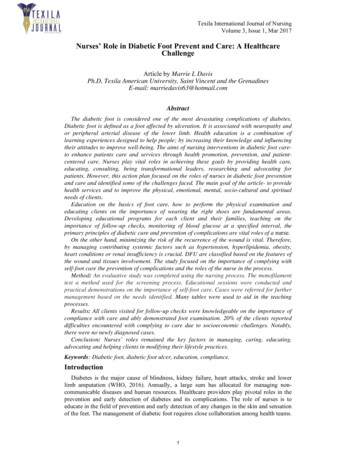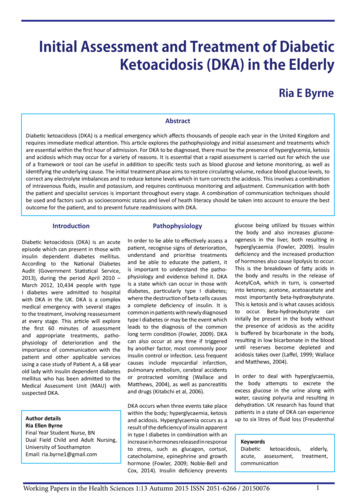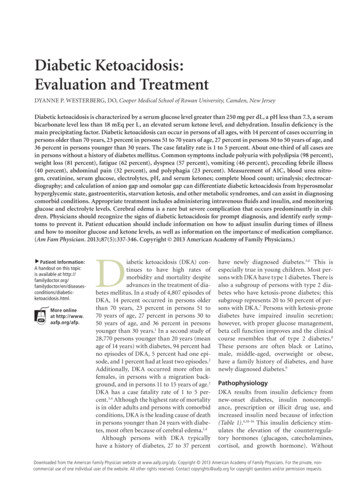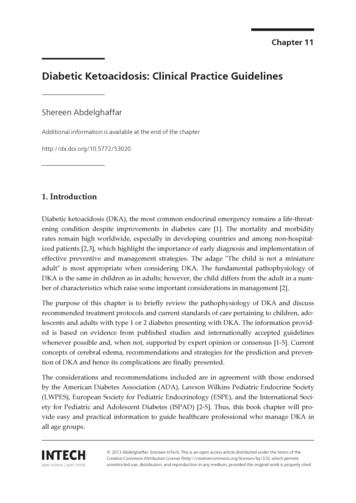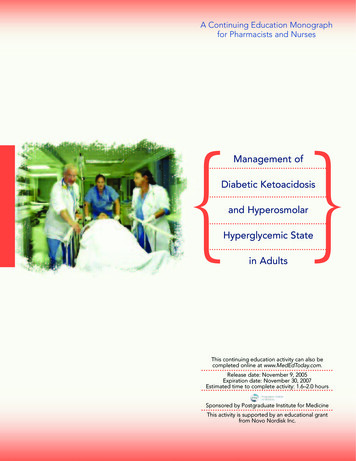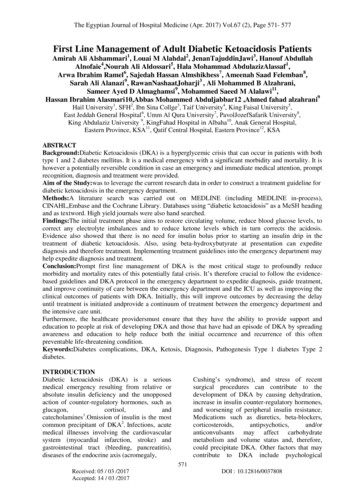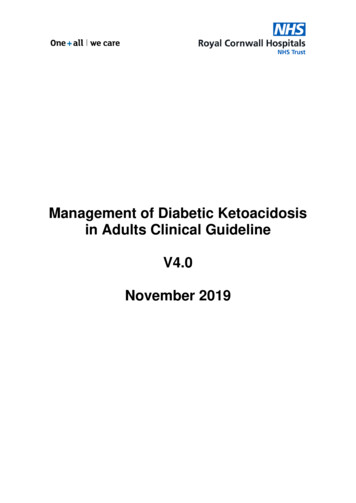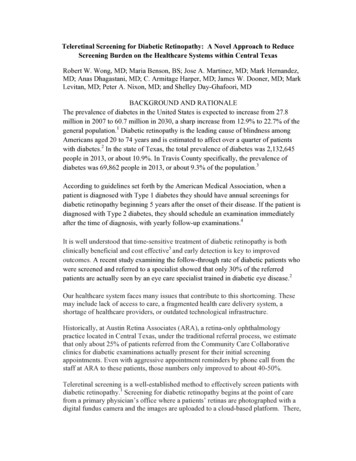
Transcription
Teleretinal Screening for Diabetic Retinopathy: A Novel Approach to ReduceScreening Burden on the Healthcare Systems within Central TexasRobert W. Wong, MD; Maria Benson, BS; Jose A. Martinez, MD; Mark Hernandez,MD; Anas Dhagastani, MD; C. Armitage Harper, MD; James W. Dooner, MD; MarkLevitan, MD; Peter A. Nixon, MD; and Shelley Day-Ghafoori, MDBACKGROUND AND RATIONALEThe prevalence of diabetes in the United States is expected to increase from 27.8million in 2007 to 60.7 million in 2030, a sharp increase from 12.9% to 22.7% of thegeneral population.1 Diabetic retinopathy is the leading cause of blindness amongAmericans aged 20 to 74 years and is estimated to affect over a quarter of patientswith diabetes.2 In the state of Texas, the total prevalence of diabetes was 2,132,645people in 2013, or about 10.9%. In Travis County specifically, the prevalence ofdiabetes was 69,862 people in 2013, or about 9.3% of the population.3According to guidelines set forth by the American Medical Association, when apatient is diagnosed with Type 1 diabetes they should have annual screenings fordiabetic retinopathy beginning 5 years after the onset of their disease. If the patient isdiagnosed with Type 2 diabetes, they should schedule an examination immediatelyafter the time of diagnosis, with yearly follow-up examinations.4It is well understood that time-sensitive treatment of diabetic retinopathy is bothclinically beneficial and cost effective5 and early detection is key to improvedoutcomes. A recent study examining the follow-through rate of diabetic patients whowere screened and referred to a specialist showed that only 30% of the referredpatients are actually seen by an eye care specialist trained in diabetic eye disease.2Our healthcare system faces many issues that contribute to this shortcoming. Thesemay include lack of access to care, a fragmented health care delivery system, ashortage of healthcare providers, or outdated technological infrastructure.Historically, at Austin Retina Associates (ARA), a retina-only ophthalmologypractice located in Central Texas, under the traditional referral process, we estimatethat only about 25% of patients referred from the Community Care Collaborativeclinics for diabetic examinations actually present for their initial screeningappointments. Even with aggressive appointment reminders by phone call from thestaff at ARA to these patients, those numbers only improved to about 40-50%.Teleretinal screening is a well-established method to effectively screen patients withdiabetic retinopathy.1 Screening for diabetic retinopathy begins at the point of carefrom a primary physician’s office where a patients’ retinas are photographed with adigital fundus camera and the images are uploaded to a cloud-based platform. There,
the images are accessed by a remote reading center and evaluated for pathology. Ifpathology is detected, an appropriate referral to a retina specialist depending ondegree of retinopathy is made. If no pathology is detected, the patient is scheduledfor a repeat teleretinal screening in 1 year.Austin Regional Clinic (ARC) is a large, private medical practice with locationsthroughout central Texas offering primary care as well as several specialty services.Close to 99% of patients seen at ARC have either government (Medicare/Medicaid orprivate, commercial health insurance. In Central Texas, patients who are uninsured,underinsured or have incomes below the poverty line may be eligible to receivehealthcare through Central Health, a safety net organization that serves thispopulation with funding from charity and municipal, state and federal subsidies.Because each of the primary care offices of both health systems are located within 5miles of an eye doctors, there is no “geographical” barrier to seeing anophthalmologist for routine diabetic screening. Nevertheless, screening rates remainlow.Teleretinal screening may reduce the burden of the screening process on the patient,the referring primary care practice as well as the ophthalmologist and ultimatelyimprove screening rates. Our study evaluates the effect of teleretinal screeningprograms in the central Texas population over both commercially insured andunder/uninsured safety net populations.PURPOSETo retrospectively analyze the impact of a novel, teleretinal screening protocol fordiabetic retinopathy and a streamlined referral process for diabetic patients within theARC and Central Health network over a 12-month period and six month period,respectively.Specifically, to report on the prevalence of diabetic retinopathy including severity ofdisease as well as other ocular pathology seen in diabetic patients in Travis Countyand surrounding counties.To report on the capture rate of patients detected with diabetic retinopathy. Thecapture rate is defined asthe percentage of patients with detected retinopathy viateleretinal screening who schedule and attend an appointment with a retina specialist.To analyze differences in diabetic retinopathy rates across each of the primary carelocations throughout central Texas.PROCEDURES
Pertinent health information from Intelligent Retinal Imaging System (IRIS)telemedicine screening database in ARC and Central Health clinics will be compiledand analyzed. This will include identifying patient demographic information, rates ofdiabetic retinopathy, rates of follow up and need for treatment.The initial screening takes place at the initial point of care within the primary careprovider’s office using a non-mydriatic (undilated) fundus camera. There are six ARCprimary care clinics and two Central Health clinics with cameras. The image is thenuploaded to IRIS’s cloud based platform where they can be remotely accessed andgraded by retinal physicians at Austin Retina Associates.After the images are graded and reported back to the primary physician’s office, ifthere is pathology necessitating further evaluation by a retina specialist, the patient iscontacted for an appointment by a referral coordinator from Austin Retina Associates.Data from IRIS will include evidence of diabetic retinopathy (DR) and DiabeticMacular Edema (DME), as well as level of DR and DME. Whether or not the imagecould be graded will also be recorded.If no diabetic retinopathy or other ocular pathology is detected, the patient is advisedto return for a scan in 12 months. For mild diabetic retinopathy (DR) or diabeticmacular edema (DME), an appointment within six months is advised. Moderate DRor DME prompts a visit within one month. If the patient has severe DR or DME orproliferative DR, they are scheduled an appointment within 2 weeks. Otherpathologies, which may be noted, have specific recommended follow up times.Period prevalence of diabetic retinopathy and diabetic macular edema were calculatedfor each of the locations. Statistical analyses were completed comparing these ratesacross each of the locations for both diabetic retinopathy and diabetic macular edema.Patient capture rate (the percentage of patients requiring further examination by aretina specialist who actually came in for an appointment) was also calculated.A geographical map detailing the distribution of diabetic retinopathy will be created.KEY FINDINGS AND CONTRIBUTIONSFor the Central Health patients, 1830 patients were screened over a six month periodfrom April 2015 to October 2015. Severity of DR and presence of DME in both
clinics is shown in Figure 1. Overall period prevalence of DR was 26.6% (486/1830).Prevalence of DR was significantly higher in the south location at 28.9% as comparedto the north location at 24.0% (p 0.05). Prevalence of DME was also significantlyhigher in the south location as compared to north (10.1% vs 6.9%; p 0.05).Screening identified 272 patients requiring referral to an ophthalmologist or 14.9%(272/1830). 1558 patients (85.1%) did not need further examination until their nextscheduled image. Overall capture rate was 65.4% (178/272). 91 of the remaining 94either declined, already had an eye doctor, or were unable to be contacted.In the ARC clinics, 3620 patients were screened over a 12 month period fromSeptember 2015 to 2016. Period prevalence of DR was 20.7% (750/3620). Ocularpathology including DR, AMD, and glaucoma, was detected in 33.4% (1209/3620).Prevalence and severity of DR and presence of DME is shown in Figure 1. Thoughthere were differences in rates of DR or DME across the six sites, they did not meetstatistical significance. 371 (10.2%) required urgent referral and of these, the capturerate was 65.5% (240/371). Therefore, 3249 patients (89.8%) did not need furtherexamination until next scheduled image.By combining the data from both sets of clinics a total 5,450 patients were screened.Prevalance was 22.7% (1236/5450). Overall prevalence of DME was 6.3%. Thecapture rate overall was 65.0% (418/643). There is a statistically significantdifference in the period prevalence of diabetic retinopathy between the central healthpopulation and the private patients from the Austin Regional Clinic. (26.6% versus20.7%, p 0.0002).CONCLUSIONSOverall, teleretinal screening for diabetic retinopathy at the point of care within aprimary care physician’s office is an effective method of screening both well insuredand underinsured patients who reside in an urban setting. A large majority of patientsscreened did not require further ophthalmology examination which may save patientsfrom additional visits to the doctor potentially saving time and resources.Our capture rate for patients requiring urgent referral is greater than previous reports inthe literature. Direct contact from the reading center’s office to these patientsimmediately following identification of pathology is a likely contributing factor toincreasing patient capture rate.We detected differences in the prevalence of diabetic retinopathy in two distinct
patients: those with commercial or government insurance as compared to patients withinthe safety net populations. Factors leading to these differences warrants further study.Strategic placement of cameras may help identify where diabetic disease with evidenceof end organ damage is more prevalent. This information may be useful toepidemiologists, physicians, health regulators and other stakeholders who makedecisions on allocations of health care resources.REFERENCES1. Gupta A, Cavallerano J, Sun JK, Silva PS. Evidence for Telemedicine forDiabetic Retinal Disease. [published online ahead of print(October 17 2016)].Seminars in Ophthalmology. 2016. doi:10.1080/08820538.2016.1228403.2. Keenum Z, Mcgwin G, Witherspoon DC, et al. Patients’ Adherence toRecommended Follow-up Eye Care After Diabetic Retinopathy Screening in aPublicly Funded County Clinic and Factors Associated With Follow-up Eye CareUse. [published online ahead of print(September 15 2016)]. JAMAOphthalmology. 2016; doi:10.1001/jamaophthalmol.2016.30813. Diabetes Data: Surveillance and Evaluation. Texas Department of State HealthServices; 2015. https://www.dshs.texas.gov/diabetes/tdcdata.shtm. AccessedNovember 3, 2016.4. American Academy of Ophthalmology Retina Panel. Preferred Practice PatternGuideline: diabetic retinopathy. tic-retinopathy-ppp-updated-2016. Updated 2016. Accessed November3, 2016.5. Conlin PR, Fisch BM, Cavallerano AA, et al. Nonmydriatic Teleretinal ImagingImproves Adherence to Annual Eye Examinations in Patients with Diabetes. TheJournal of Rehabilitation Research and Development. 2006; 43(6):733-740
Figure 1: Location of Primary Care Locations within Central Texas where Patients areScreened for Diabetic Retinopathy Using the Teleretinal ImagingFigure 2: Teleretinal Imaging Camera
Table 1: Prevalence of Diabetic Retinopathy and Diabetic Macular Edema in PrimaryCare Locations within Central Texas
Teleretinal screening is a well-established method to effectively screen patients with diabetic retinopathy.1 Screening for diabetic retinopathy begins at the point of care from a primary physician’s office where a patients’ retinas are photographed with a digital fundus camera and the images are uploaded to a cloud-based platform. There,File Size: 760KB
